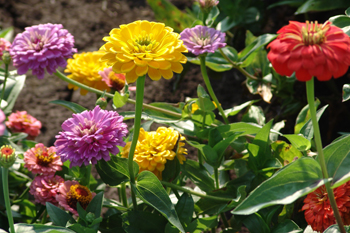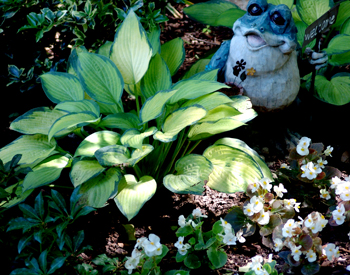Defining Sun Requirements for Plants
Shedding Light on Sun/Shade Conditions
Return to Environment, Light and Water Agent Articles
 As gardeners there is a lot to know when caring for our plants. We have been told the key to success is right plant, right place. That phrase is easy to say but has a lot of elements to dissect in order to create a lush beautiful garden. Soil, water, fertility, and, maybe the most misunderstood of all, light exposure.
As gardeners there is a lot to know when caring for our plants. We have been told the key to success is right plant, right place. That phrase is easy to say but has a lot of elements to dissect in order to create a lush beautiful garden. Soil, water, fertility, and, maybe the most misunderstood of all, light exposure.
Defining sun requirements
We have all picked up a plant tag and read needed light requirements — sun, part sun, part shade or shade. What does that all mean? It is enough to just make you want to throw up your hands and walk away. Understanding light exposure or sun/shade patterns is not easy but with a little help we might be able to shed a little light on this topic.
Light patterns is really about understanding microclimates in our garden and then finding the right plant that will thrive in the right spot. Increasing hours of sunlight in the Kansas City area means heat, while shade conditions may be 10 to 15 degrees cooler and more humid. Plants have adapted over time to favor a particular condition for best growth. It is our challenge to mimic these conditions if we want the most from our investment.
Full sun
Full sun is pretty easy for most of us to grasp but it becomes a little cloudier when determining the levels of shade. Full sun is direct summer sun for six or more hours per day. In nature full sun would be the meadows or open prairie spaces. In our KC backyards we define full sun as at least six hours or more of sun each day.
Shade — light, partial, full and dense
Shade is more complicated. It's about varying degrees of relief from the sun. Shade might be easiest to define if we break it down into four classes from light to dense shade.
Light shade can be defined as receiving between three and five hours of direct sun in the summer. Light shade may be the best growing conditions in our brutal summers here. These locations are sunny enough that many sun loving plants will grow while many shady lovers can still make it. Keep in mind that morning sun, which is cooler and less intense, is easier on shade loving plants then the hot afternoon sun. Plants that receive too much intense light will scorch if pushed into too much hot sun.
 Partial shade is often defined as an area that receives two hours of direct sun each day or shaded for at least half the day. Here again, remember the difference between morning and afternoon sun and its effects on some more shade loving plants. Partial shade is good for many flowering shrubs that will produce more blooms with a little sun. These would include such plants as azaleas, rhododendrons and macrophylla hydrangeas.
Partial shade is often defined as an area that receives two hours of direct sun each day or shaded for at least half the day. Here again, remember the difference between morning and afternoon sun and its effects on some more shade loving plants. Partial shade is good for many flowering shrubs that will produce more blooms with a little sun. These would include such plants as azaleas, rhododendrons and macrophylla hydrangeas.
Partial shade can also be found under or around trees. This is hard to determine but these conditions can exist under or near trees that have less than 50 percent canopy. It can also be found in the reflections of light off of buildings. Another way to look at partial shade would be more cooler morning sun and little or no hot afternoon sun.
Full shade is the third type of shade. These areas take in less than an hour of direct sunlight each day. It could also be dappled light through a tree canopy for most of the day. Full shade is not just a result of trees but also buildings, fences and other structures that cast shadows or block the sun rays.
When planting in full shade soil moisture can be an issue. Dry shade presents additional challenges for plant selections as the competition with tree roots can be high. Plants in this area should not only be shade tolerant but also drought tolerant unless supplemental water will be applied.
Dense shade is the last in this category. It which means no direct sunlight and little indirect light seldom reaches the ground. This would be the light under evergreen trees or overhangs of buildings. It can be found under shrubs, decks and dark corners and passages between houses. The ground is usually dry and dark from lack of light.
Dense shade is the most difficult and limiting growing condition. Plant selections are few due to the combination of shade, root competition, and dry soil conditions. Decorative mulches or ground covers are good alternatives for areas with dense shade.
What does the plant need? Read the tag.
 Understanding the sun and shade patterns of the garden is only part of the equation. The second part is understanding the plant needs. Here again this can be confusing as plants can adapt to several light levels. The adaptation is related in many ways to the intensity of the sunlight. Remember morning sun is cooler and less intense. It does not lead to leaf scorch and stress. Some plants can tolerate a lot more sun if it was morning sun as opposed to the hot, scorching afternoon sun.
Understanding the sun and shade patterns of the garden is only part of the equation. The second part is understanding the plant needs. Here again this can be confusing as plants can adapt to several light levels. The adaptation is related in many ways to the intensity of the sunlight. Remember morning sun is cooler and less intense. It does not lead to leaf scorch and stress. Some plants can tolerate a lot more sun if it was morning sun as opposed to the hot, scorching afternoon sun.
Plant growers try to help us figure out the needs. Many times on a plant tag there will be references to light requirements. Tags will say such things as sun, sun – part shade, shade. It can also get confusing as another tag can say shade – part sun. So what does that mean when several light levels are listed?
Here is the simple key to understanding the tag. The first word describing the light requirement would be the plants preferred location. For example "sun – part shade" means the plant will grow best in full sun but tolerate some shade. While a tag reading "part shade – sun" would prefer less sun or maybe morning sun over hot afternoon sun. Does that make sense or are you still in the dark?
Another problem we face in determining light levels is where the plant was produced and who rated its sun and shade tolerances. Full sun in Seattle or Minneapolis is really not the same intensity as full sun in Kansas City or Oklahoma City. Here in Kansas City our hostas scorch with hot afternoon sun. Head north and you will see them happy as a clam in full sun. It all goes back to intensity; the difference between morning and afternoon sun. Ample soil moisture can help compensate for the effects of the sun on plant growth.
I feel like I have maybe confused you more than I helped. Understanding sun/shade patterns is not easy. But with a little thought, and good old trial and error you can soon figure out what is right for your favorite plant. One last thought. You planted in too much sunlight or shade? The solution is simple, just transplant to a new location. Weren’t plants meant to be planted on wheels as they seem to just keep shifting locations in the garden?
Have questions?
The Garden Hotline is staffed by trained EMG volunteers and Extension staff who will assist you with questions. Phone: (913) 715-7050. Email: garden.help@jocogov.org